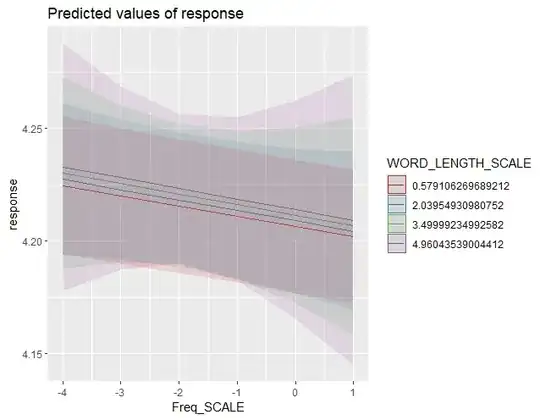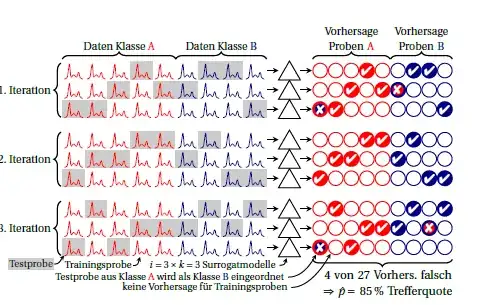this may be a beginner’s question, but any help is appreciated! First, how to interpret the interaction between continuous variables? Such as WORD_LENGTH_SCALE:Freq_SCALE and WORD_LENGTH_SCALE:Freq_SCALE:Freq_2nd?
Here are my codes (Freq_2nd is not applicable to a word length condition. That is, when the word length = 1, Freq_2nd is NA. Thus, i wrote is as (WORD_LENGTH_SCALE:Freq_2nd)):
fm = lmer (response ~ WORD_LENGTH_SCALE * Freq_SCALE *
(WORD_LENGTH_SCALE:Freq_2nd) + (1| subjects) + ( 1 | trail_no),
data = data_01, REML = TRUE)
and the results:
Fixed effects:
Estimate Std. Error t value
(Intercept) 4.205600 0.015334 274.272
WORD_LENGTH_SCALE -0.025104 0.015568 -1.613
Freq_SCALE -0.004509 0.001953 -2.309
WORD_LENGTH_SCALE:Freq_SCALE -0.019313 0.008061 -2.396
WORD_LENGTH_SCALE:Freq_2nd 0.004601 0.002513 1.831
WORD_LENGTH_SCALE:Freq_SCALE:Freq_2nd 0.003309 0.001370 2.416
Correlation of Fixed Effects:
(Intr) WORD_LENGTH_SCALE F_SCAL WORD_LENGTH_SCALE:Fr_SCALE WORD_LENGTH_SCALE:F_2
WORD_LENGTH_SCALE -0.029
Freq_SCALE 0.145 0.093
WORD_LENGTH_SCALE:Fr_SCALE -0.015 0.849 0.051
WORD_LENGTH_SCALE:F_2 -0.024 -0.958 -0.295 -0.825
WORD_LENGTH_SCALE:F_SCALE: -0.033 -0.785 -0.284 -0.957 0.839
Second, I used the ggeffects, sjPlot and prediction function to plot graphs, but they seem different from the model. In the model, the Freq_SCALE and WORD_LENGTH_SCALE are negative, while in the plot, the Freq_SCALE is negative but the WORD_LENGTH_SCALE is positive. Why is this the case?
Third, what is the most reliable way to visualize the mixed model? sjPlot and the prediction function give me different plots. So I am not sure what to do ...
sjPlot
prediction:


